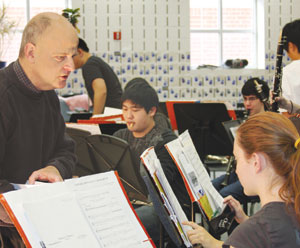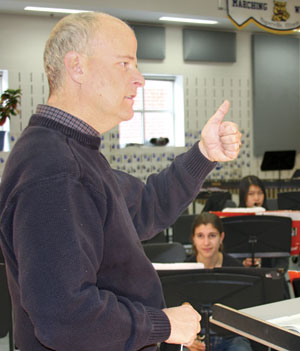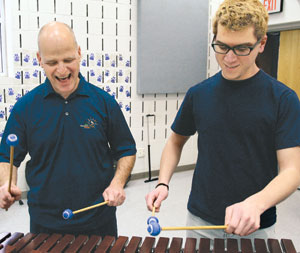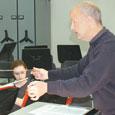
When school began in the fall, the Wind Ensemble spent the first five weeks of rehearsals getting its center of sound,” says Charles Staley, band director and chairman of the fine arts department at Neuqua Valley High School. “That included some good-quality time with Bach, which helped us a lot.” Those early weeks in the fall of 2009 were critical to Staley, whose attention was on preparing the school’s top ensemble for a performance at the Midwest Clinic in December.
“I used Bach,” he says, “because this is an advanced group, and his music is probably the most difficult music to play. Bach forces musicians into all kinds of mental gymnastics that help them understand problems with balance and changes in tone color based on register and volume. The higher or the lower the register, depending on the instrument, tone color will change and that is not always desirable. My goal is to have students even out those problems and keep control of the instrument. I’m a huge fan of Pablo Casals, and if Bach’s music was good enough for him to study for a lifetime, then it’s good enough for my students to study for a month.” 
The Wind Ensemble is one of eight curricular bands at Neuqua Valley (marching band is extracurricular); the school has an enrollment of 4,500 students with over 1,200 in the music department and some 500 in the band program. As director of the fine arts department, Staley guides the work of 20 art and music teachers. The music program has received numerous awards, including the 2009 Grammy Signature Gold Award; the fine arts department was also honored with the John F. Kennedy Center for the Arts National Schools of Distinction in Arts Education Award.
A Special Place for Students
Staley views the Neuqua Valley music department as a special place because every student, regardless of ability, can attend rehearsals, participate, and feel as though he is an important part of the community. Even with 500 people in the band program, staff members treat the students in the less-experienced ensembles with the same kind of care and passion for music making as they do the Wind Ensemble, a group that is receiving national recognition.
“Students want to feel satisfaction from the moment they enter the band room to when they leave, as far as making progress towards a common goal. Not many are interested in finding satisfaction only through performance.”
To promote musical growth, Staley says, “We offer a 20-minute technique class each week where students meet with a director and receive expert guidance in developing skills, such as articulation and phrasing. This is a small group lesson that focuses on learning to overcome technical problems in order to play more musically; it is not a sectional to learn the band music.
“We also have a series of exercises that students complete for each level of instruction. For the Symphonic Bands, for example, players complete level four of our technique curriculum that uses the Rubank Intermediate Method Book (Hal Leonard) as its core material. Students in the Symphonic Bands are not required to study privately, so they set performance goals with the help of the music staff, which is separate from the ensemble work. That effort, along with expert instruction as an ensemble, makes them capable of playing musically.”
Guest Clinicians
“For the end-of-the-semester assessment for the Symphonic Bands, which are nonaudition groups, we bring in an expert clinician to work on the pieces they are preparing. That expert gives them a culminating activity by crafting the work at the highest level; it would be the same as the Wind Ensemble asking Mallory Thompson of Northwestern University to come in for an event. An ensemble is at a particular level in its development, and the clinician takes them to the next level.
“We’ve had Ross Kellan from Elmhurst College and Ron Polancich from Roosevelt University work with our Symphonic Bands. Some of the works prepared by these groups were Courtly Airs and Dances by Ron Nelson (LudwigMasters), Fantasy on American Sailing Songs by Clare Grundeman (Boosey & Hawkes/Hal Leonard), Freedom Road by Jim Curnow (Curnow Music), and Chorale and Shaker Dance II by John Zdechlik (Kjos). We treat our Symphony Bands exactly the way we treat our top ensemble by selecting great music and preparing our students for intense scrutiny by outside experts.”
With the recent accolades for the Wind Ensemble, Staley’s principal asked what he was the most proud of. “The only thing I could think of was one of the Symphonic Bands, a group that has about 80 students who just want to play. It’s a nonaudition group including many seniors who are thrilled to make music together, performing works they love.
“I’m proudest of the fact that no matter where students fall in the hierarchy of the program, there is a place where they can feel comfortable performing music. They should leave this place feeling good about the experience they had.”
The Right Music at the Right Time

Staley and his staff devote large amounts of time to finding the right literature for each ensemble. It has to be sophisticated enough to keep the students interested and to reflect the fact that they are responsible young adults who will learn the music. Repertoire that is too simplistic gives students the impression they are still in middle school.
“It’s a happy time when we can match the literature with the students’ abilities and also help them to develop musically. The music is not in a simple ABA form all the time, and it doesn’t always have to follow a fast-slow-fast model. It is well-crafted music that stimulates a deeper understanding of form and harmony. It’s tough to find.”
Sitting In
In the past some Neuqua Valley band students have performed in more than one ensemble, especially those interested in teaching who play secondary instruments. “Once a flute player in the Wind Ensemble wanted to learn oboe and played it in the Symphonic Band. We’ve also had people in the Wind Symphony, our second most experienced group, play in the Wind Ensemble if we need an English horn and two oboes for concerts. If we need a bass trombone or an extra percussionist, we’ll ask people from other ensembles to help.”
There isn’t a lot of flow between groups, but when Staley needs special instrumentation, the students help out. “There are few rehearsals outside of the school day, so to get someone to fit in with an ensemble, I have to be careful to have the right part so students can prepare on their own and then play with us at a dress rehearsal.”
Constructive Criticism
The music faculty at Neuqua Valley agrees that the most important part of their work is developing the students’ abilities. Perhaps the best example is when Staley invites other instructors to listen to the Wind Ensemble and give him feedback about the performance. “Music teachers understand the motivation for constructive criticism is to help everyone learn and to sound better. You need another set of ears, and none of the staff is afraid to help for fear that something may be misconstrued.
“Constructive criticism is welcomed by all of the music faculty, especially if it is accurate and helpful. Neuqua Valley’s principal, Bob McBride, came up with the term critical friends, and I like the idea of being a critical friend. If you think of criticism that way, then your approach becomes one of building up without necessarily tearing down.
“When teachers and students have a trusting relationship, it’s a lot easier for the students to accept criticism when things aren’t correct. We are all interested in having the music be as good as it can be; that is the only goal. Although the goal is never to criticize a person, teachers often fall short, just because of the pressures of performance. As experienced adult musicians, we have heard suggestions that help us to improve quickly – even though the person providing the feedback didn’t take into consideration the fact that his criticism was hurtful.”
The Critical Friend
There are no simple formulas for being a critical friend. It is not just a matter of telling students something positive before you present a laundry list of problems about their playing. Staley believes it is more about the teacher and students sharing ideas about the music. “It’s something that develops over time: you are focusing on a goal that everyone in the ensemble agrees on, which is meeting the intent of the composer. It means any criticism is really to benefit the music, and it is up to the director to convince students that is what it is, plain and simple. It is not a criticism of anyone as a person, and it isn’t something that originates in a teacher’s mind that no one else understands.”
Teachers Who Ignite Talent

Staley recommends that band directors read the book The Talent Code by Daniel Coyle (Bantam) because it describes talent, even athletic talent, from the perspective that people have igniters in their life who say just the right thing and have just the right intent that it ignites talented individuals with the ideal of perfection or excellence. One person provides the spark, and another person takes off with it.
“Conversely, some people are annihilators, figuratively taking a bucket of water and pouring it over a student. It takes a long time for the person to “dry out.” If you do that, even in a trusting relationship, it takes the person a while to feel any enthusiasm for developing his talent because the teacher has really dampened his spirit.
“All of us can be annihilators, especially because in the urgency of the moment it seems more expeditious to fix the symptom – but you don’t necessarily address the problem. For example, there is the problem of students who tune every note to a tuner that drives directors crazy. It’s fixing the symptom without understanding the problem, which has to do with the function of equal temperament.
“For me to focus on the symptom of an out-of-tune triad during band rehearsal doesn’t work. A student can tune the third to the tuner, and the chord remains out of tune. He has to understand the principles behind tuning a major third, which has to be tuned lower, and a minor third, which has to be tuned higher, to tune a third. Solving the problem happens when students understand how to tune the fifth first and then add the third so that it sounds correct to their ear, because the result will be better than the tuner.”
Critical Friend, Reprise
Staley says that if he is always the one to generate solutions to whatever musical problems occur in a work, then the students never become responsible for making improvements. “If students become engaged in solving problems, they become better musicians and thus learn to serve the music. Whereas if they depend on me for the time, the tuning, or a smiling face or a frowning face for their tone, I will paralyze them. .jpg)
“If they are waiting for permission, the result can’t be musical. This goes back to the idea of being a critical friend to students. They come to understand that I respect and admire them so much that I trust they will take responsibility for their parts and together we will make the music happen.
“I was pleased, for instance, at the Midwest Clinic when Dennis Glocke guest conducted ‘Wonderous Love’ from Southern Harmony by Donald Grantham (Piquant Press). The clarinet has a solo at the beginning and then the flutes enter. It was terrifically out of tune to my ear, but the musicians dissolved into being tuned correctly so quickly that I forgave them.
“As a teacher I was gratified because had they depended on me to fix the problem, I wasn’t there; and Professor Glocke wasn’t going to do it. It was up to the students, and they shouldered the responsibility by immediately adjusting. A musician is brilliant beyond means if he can come in perfectly in tune after a solo line when the harmony, the tonality, is not yet established. These students got it. They adjusted immediately because that is what we do.
“Steve Squires at Roosevelt University says it best when he comments that even the Chicago Symphony Orchestra plays out of tune, but they adjust so quickly no one can tell except for them. They know. The Wind Ensemble is not at the level where it is instantaneous, but tuning is certainly not going to detract from a performance.”
Awards for Excellence
In 2009 Neuqua Valley High School was the only public school in the country to earn the Kennedy Center Award for Excellence in the fine and performing arts. It was a detailed, extensive project, Staley says. “We have a fabulous 20-minute video of basically what Neuqua Valley offers in the arts – dance, multi-cultural choir, all of the visual arts, and musical theater – with snippets of each of those productions. The music that we used in the background was 20 minutes of samplings of each of our ensembles.
“In addition, we had to give a full accounting of the curriculum, describing it in detail so that someone who was reviewing the materials for the first time would be able to visualize what is available to students in the arts.”
The music department also received the Grammy Gold Status Award and the Grammy National Signature School award in recognition for having the best high school music program in the United States. “Anyone can apply for those awards. The first round is basically an accounting of what the school offers students; it’s not a review of the quality of the program. From that information, the Grammy Foundation staff invites schools to submit more information to be considered for the actual award.
“There are some 30,000 high schools in the country, so in theory 30,000 programs could apply. From those who apply the organization selects 300 high schools in the country to apply for the final award. I like the Grammy process because it honors schools that have a comprehensive program, so you have an opportunity to submit recordings of all of your groups.
“It might get the wheels churning for schools that don’t have an orchestra and the administration would really like to be recognized. An orchestra is at least a third as important; it’s 33% of a music program. I really like that message.
“Another enjoyable aspect about the process is that we record everything for our purposes, so the instructors can evaluate what a group is doing and the students can hear their playing. Everything is professionally recorded. We take all of our recordings, literally hours and hours of recording, and the staff picks the excerpts they think represent our very best work.
“The process of listening to everything that has been recorded in a year provides me with professional growth. When we use the recordings to consider musical problems to solve and greater attention to detail, I listen differently than when I’m seeking out the very best musical moments for outside scrutiny.”
The Measure of a Program
Do these award programs motivate students to practice more? Staley says no. While everyone is proud of the distinction, he doubts that students spend an extra 10 minutes a day in the practice room because of them.
“The payoff for the students is that we rehearse as we perform. They love playing in these ensembles because every class period has musical moments. A performance is stringing together as many consecutive musical moments as possible. It’s hard to describe, but when you are in a very fine ensemble as a musician, gaining approval from outside your world seems less motivating than the music you make every day.
“Rather than speculating if we might garner more awards this year, my students will ask, ‘What are we going to do to make music today?’ or ‘What music is in our slots?’ That is what is most important to each student, and that is the most effective motivation tool.”





